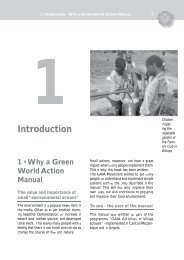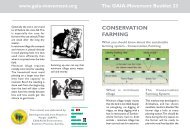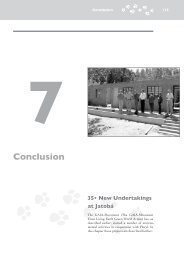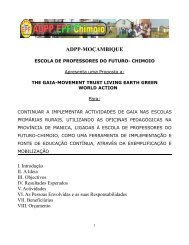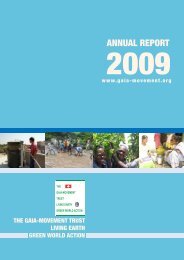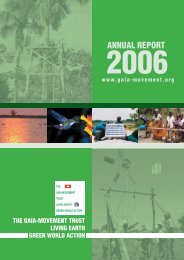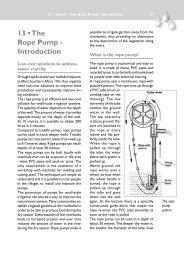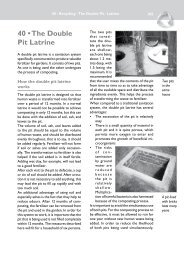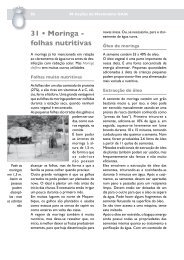Reducing water consumption - The Gaia-Movement
Reducing water consumption - The Gaia-Movement
Reducing water consumption - The Gaia-Movement
You also want an ePaper? Increase the reach of your titles
YUMPU automatically turns print PDFs into web optimized ePapers that Google loves.
DEDICATED TO MAKING A DIFFERENCE<br />
World Business Council for<br />
Sustainable Development<br />
Eskom<br />
<strong>Reducing</strong> <strong>water</strong> <strong>consumption</strong><br />
Situation<br />
Case study<br />
2006<br />
Eskom is a large consumer of fresh<strong>water</strong> in South Africa, accounting for approximately<br />
1.5% of the country’s total <strong>consumption</strong> annually. Eskom power stations run constantly,<br />
supplying in excess of 95% of South Africa’s electrical energy and more than half of the<br />
electricity used on the African continent. Without <strong>water</strong>, this output would not be possible.<br />
Eskom uses raw <strong>water</strong>, which is put through extensive purification and treatment before<br />
entering the production processes. <strong>The</strong> salinity of the raw <strong>water</strong> dictates the volume of<br />
effluents that are produced during the treatment process. During 2004, Eskom used<br />
277.6 million cubic meters of <strong>water</strong> for electricity generation, mainly at its coal-fired power<br />
stations.<br />
<strong>The</strong> <strong>water</strong> catchment areas in which many of Eskom’s power stations were built are<br />
relatively <strong>water</strong> scarce, necessitating the need for inter-basin transfers. Over the years,<br />
various <strong>water</strong> supply schemes have been constructed to supply the necessary <strong>water</strong> to<br />
the power stations. <strong>The</strong>se schemes consist of dams, pipelines, pumping stations and<br />
reservoirs and are inter-linked and operated as a system.<br />
Targets<br />
It is expected that Eskom’s <strong>water</strong> <strong>consumption</strong> will increase over the next 10 years, due<br />
to increased demand for electricity. However, decades ago Eskom recognized that the<br />
organization would have to find ways of limiting increases in <strong>water</strong> <strong>consumption</strong> and<br />
contribute to sustainable <strong>water</strong> use in South Africa. Eskom is thus committed and<br />
determined to support the drive to improve the management of South Africa’s<br />
scarce <strong>water</strong> resources.<br />
Water use targets in terms of liters of <strong>water</strong> used per unit of electricity sent out are set for<br />
each power station every year. <strong>The</strong> <strong>water</strong> targets are linked to the Eskom Sustainability<br />
Index contained in performance compacts, which are in turn linked to business unit and<br />
individual performance bonuses. <strong>The</strong> targets are benchmarked against historical as well<br />
as theoretical <strong>water</strong> <strong>consumption</strong> for each particular type of plant.<br />
Activities<br />
Management strategies are formalized in the company’s Environmental Management<br />
Policy and more specifically its Water Management Policy. <strong>The</strong>se policies are cascaded<br />
down into all levels of the organization. Where relevant, specific business units have their<br />
own <strong>water</strong> policies, standards and guidelines.<br />
Over the last two decades Eskom has introduced a number of innovative technologies to<br />
save <strong>water</strong>. <strong>The</strong>se include dry cooling, desalination of polluted mine <strong>water</strong> for use at the<br />
power stations, and technical improvements on treatment regimes to maximize the<br />
beneficial use of <strong>water</strong>. In so doing, more than two hundred million liters of <strong>water</strong> are<br />
saved every day.
a) Dry Cooling Technology<br />
A conventional wet-cooled power station uses a recirculating system in which cooling<br />
takes place via evaporation in an open cooling tower. Approximately 85% of the total<br />
quantity of <strong>water</strong> supplied to a power station evaporates through these open cooling<br />
towers. In contrast, dry-cooling technology does not rely on evaporative cooling for the<br />
functioning of the main systems. As a result, overall power station <strong>water</strong> use is<br />
approximately 15 times lower than a conventional wet-cooled power station. For this<br />
reason, Eskom has implemented dry-cooling technology on power stations wherever<br />
feasible, despite the fact that dry-cooled stations comparatively are less efficient than<br />
wet-cooled stations and there are higher capital and operating costs associated with the<br />
technology. This <strong>water</strong> conservation effort results in an estimated combined savings of<br />
over 200 Ml/day, or in excess of 70 million m 3 /annum.<br />
Matimba Power Station near Ellisras in the Northern Province is the largest direct drycooled<br />
station in the world, producing more than 4,000 Megawatts (MW). It makes use of<br />
closed-circuit cooling technology similar to the radiator and fan system used in motor<br />
vehicles. Water <strong>consumption</strong> is in the order of 0.1 liters per kWh of electricity sent out,<br />
compared with about 1.9 liters on<br />
average for the wet-cooled stations.<br />
<strong>The</strong> choice of dry-cooled technology<br />
for Matimba was largely influenced by<br />
the scarcity of <strong>water</strong> in the area.<br />
Kendal Power Station near Witbank in<br />
the Mpumalanga Province, is the<br />
largest indirect dry-cooled power<br />
station in the world, with a <strong>water</strong><br />
<strong>consumption</strong> in the order of 0.08 liters<br />
per kWh of electricity sent out. Indirect<br />
dry-cooling entails the cooling of the<br />
<strong>water</strong> through indirect contact with air<br />
in a cooling tower, a process during<br />
which virtually no <strong>water</strong> is lost in the transfer of the waste heat.<br />
Figure 1: Matimba Power Station during<br />
construction<br />
b) Desalination<br />
Where power station design permits, Eskom has endorsed a policy of zero liquid effluent<br />
discharge (ZLED) at its wet cooled stations. In terms of the ZLED policy, <strong>water</strong> is<br />
cascaded from good to poor quality uses until all pollutants are finally captured in the ash<br />
dams. <strong>The</strong> objective<br />
is to dispose of the<br />
maximum mass of<br />
salts with the<br />
smallest possible<br />
volume of <strong>water</strong><br />
without<br />
compromising the<br />
ability of the ash to<br />
encapsulate the salt<br />
load imposed.<br />
WBCSD page 2<br />
<strong>The</strong> effective use of<br />
this practice has<br />
Figures 2 and 3: Finned tube condensers above forced draught fans<br />
seen the company<br />
introduce the use of<br />
desalination plants at two of its power stations, namely Lethabo and Tutuka. <strong>The</strong>se<br />
treatment processes allow the company to introduce polluted mine-<strong>water</strong> from the tied<br />
collieries for re-use at the power stations. This assists with the prevention of negative<br />
environmental impacts on the surface and ground <strong>water</strong>s of the country.
Figure 4: Kendal Power Station<br />
WBCSD page 3<br />
Tutuka Power Station, near Standerton in<br />
Mpumalanga, is a wet-cooled station using a dry<br />
ashing system, where moistened ash is conveyed<br />
to the ash dump on overland conveyors.<br />
Blowdown <strong>water</strong> from the concentrated cooling<br />
<strong>water</strong> (CCW) system is used for ash conditioning.<br />
When the power station operates at a low load<br />
factor the amount of ash generated is normally<br />
insufficient to contain all the blowdown <strong>water</strong>. Also,<br />
the salinity of the Vaal River <strong>water</strong> used at the<br />
station, in combination with the dry ashing system,<br />
limits the station’s ability to contain <strong>water</strong> in the<br />
ashing system. A desalination plant was therefore required to reduce the volume of <strong>water</strong><br />
that is disposed of at the ash dumps, to counteract the effect of the poor <strong>water</strong> quality.<br />
For this reason, the power station’s<br />
desalination plant was built in 1985.<br />
<strong>The</strong> product of the desalination plant<br />
is mainly fed into the CCW system,<br />
whilst the brine is used for ash<br />
conditioning. Initially, the plant was<br />
intended to be used only for the<br />
treatment of the CCW blowdown. In<br />
an effort to explore existing and<br />
possible synergies between the<br />
power station and its mine, New<br />
Denmark Colliery, it was realized<br />
that greater benefits will be derived<br />
from treating the mine’s <strong>water</strong> in<br />
addition to the CCW blowdown.<br />
c) Water Infrastructure<br />
Eskom has over the past 40 years contributed to the development of an extensive<br />
network of pipelines and dams with the South African Department of Water Affairs and<br />
Forestry (DWAF), especially on the Mpumalanga Highveld. This has been done through<br />
partnering with DWAF in either directly contributing<br />
to the infrastructure development financially or by<br />
joint involvement in projects. <strong>The</strong>se projects,<br />
primarily aimed at providing a secure <strong>water</strong> supply to<br />
the power stations and their associated collieries,<br />
has had a significant impact on the viability of<br />
supplying <strong>water</strong> to both industries in the area and<br />
<strong>water</strong> for domestic use. Currently, Eskom is the<br />
major contributor to a pipeline linking Vaal Dam to<br />
the <strong>water</strong> supply system on the Mpumalanga<br />
Fig 7: <strong>The</strong> desalination plant and<br />
high -pressure pump<br />
Figures 5 & 6: Tube bundle heat exchangers<br />
within the cooling tower.<br />
Highveld which would provide <strong>water</strong> security to the<br />
area for the next 20 years.<br />
d) Water Metering and Monitoring<br />
<strong>The</strong> DWAF measures the <strong>water</strong> they supply to the power stations at the boundary of the<br />
power station terrace. Eskom and DWAF has adopted a metering procedure which has<br />
seen the implementation of revenue class meters that measure to a level of accuracy of<br />
0.5%. This is an improvement on the previously accepted 5% level of accuracy.<br />
On the power station terraces ongoing meter verification and upgrades takes place. Both<br />
on-terrace and third party users’ <strong>water</strong> meter readings are taken at least once per month.<br />
Water balances and salt balances are carried out at least once a month using the<br />
readings to verify performance and identify potential problems. At the power stations,<br />
inspections are carried out during every shift and any leaks are recorded and reported for
epair as part of their formal reporting systems and maintenance procedures. On the raw<br />
<strong>water</strong> supply pipelines, major leaks are rapidly indicated by the remote supervisory<br />
control system that senses any reduced <strong>water</strong> levels in the terminal raw <strong>water</strong> reservoirs<br />
at the power stations. Regular pipeline inspections are carried out to identify minor leaks<br />
and all leaks are recorded in mandatory inspection schedules. Water balances are also<br />
carried out monthly on the <strong>water</strong> supply systems.<br />
e) Demand Side Management<br />
Electricity demand side management as practiced in Eskom endeavors to integrate the<br />
demand and supply side options to find the lowest cost options for the provision of<br />
electricity. Demand side management in electricity may be defined as the practice of a<br />
supplier of electricity influencing the manner in which its customers use electricity to<br />
increase the beneficial use of the commodity. Although <strong>water</strong> conservation has not been<br />
the primary motive for these initiatives, there have been <strong>water</strong> savings spin-offs. For<br />
every kilowatt-hour of electricity that is saved, approximately 1.26 liters of <strong>water</strong> is also<br />
saved on average.<br />
WBCSD page 4<br />
f) International Co-operation<br />
Eskom is a participant in the Southern African Power Pool, which allows for the trading of<br />
electricity between countries in Southern Africa. This means that Eskom can import<br />
electricity from neighboring countries to meet increased demands. Since the electricity<br />
generated in the countries to the north of South Africa is mainly from hydro power<br />
stations, e.g., Cahora Bassa in Mozambique, the importation of this electricity effectively<br />
reduces the utilization of South Africa’s <strong>water</strong> resources for electricity generation.<br />
Results<br />
<strong>The</strong> quantity of energy produced between 1993 and 2004 has increased by 43%, as<br />
opposed to an increase in <strong>water</strong> <strong>consumption</strong> by 27% (Figure 8). This improved <strong>water</strong><br />
use efficiency equates to a cumulative saving of 1 400 million m 3 over the period if<br />
compared to the quantity of <strong>water</strong> that would have been used if these power stations<br />
were of the wet cooled type. This is approximately five times Eskom’s average <strong>water</strong> use<br />
per annum.<br />
TWh<br />
240<br />
220<br />
200<br />
180<br />
160<br />
140<br />
120<br />
100<br />
100<br />
1988 1990 1992 1994 1996 1998 2000 2002 2004 2006<br />
Year<br />
Total Energy Sent Out (TWh) Total Water Consumed (million m3)<br />
Figure 8: Water use compared to energy produced<br />
350<br />
300<br />
250<br />
200<br />
150<br />
milliom m 3
Access to <strong>water</strong> and <strong>water</strong> availability remains a key factor in ensuring the sustainability<br />
of development in southern Africa. <strong>The</strong> efforts by Eskom to use this precious resource<br />
more efficiently are an integral part of the company’s commitment to sustainable<br />
development.<br />
<strong>The</strong> Sustainability Index (SI) was introduced in 1996 to ensure long-term sustainability of<br />
Eskom’s business in the technical, financial, social and environmental arenas. <strong>The</strong><br />
specific <strong>water</strong> use indicator (l/kWh) forms part of the SI, and is included in the<br />
performance contracts of all those who have an impact on the organizations <strong>water</strong> use.<br />
<strong>The</strong> implementation of Eskom’s <strong>water</strong> conservation initiatives, i.e., dry cooling, ZLED and<br />
the focus on the judicial use of <strong>water</strong> at all facilities, has resulted in a significant reduction<br />
in the overall specific <strong>water</strong> <strong>consumption</strong> over the years, from approximately 2.85 l/kWh<br />
in 1980 to 1.26 l/USO in 2004 (Figure 9).<br />
Specific Water Use (L/USO)<br />
2,000<br />
1,800<br />
1,600<br />
1,400<br />
1,200<br />
1,000<br />
WBCSD page 5<br />
1989 1990 1991 1992 1993 1994 1995 1996 1997 1998 1999 2000 2001 2002 2003 2004<br />
Figure 9. Specific Water Use for Eskom<br />
About the WBCSD<br />
<strong>The</strong> World Business Council for Sustainable Development (WBCSD) is a coalition of leading<br />
international companies that share a commitment to the principles of sustainable development via<br />
the three pillars of economic growth, ecological balance and social progress. All regions of the<br />
world and most major industry sectors are represented in our membership. <strong>The</strong> WBCSD also<br />
benefits from a global network of national and regional business councils and partner organizations<br />
representing a large and diversified group of business leaders.<br />
Our mission is to:<br />
• Provide business leadership as a catalyst for change towards sustainable development;<br />
• Support the business license to operate, innovate and grow in a world increasingly shaped by<br />
sustainable development issues.<br />
4, chemin de Conches Tel: +41 (22) 839 31 00 E-mail: carpenter@wbcsd.org<br />
CH – 1231 Conches-Geneva Fax: +41 (22) 839 31 31 Web: www.wbcsd.org<br />
Switzerland



